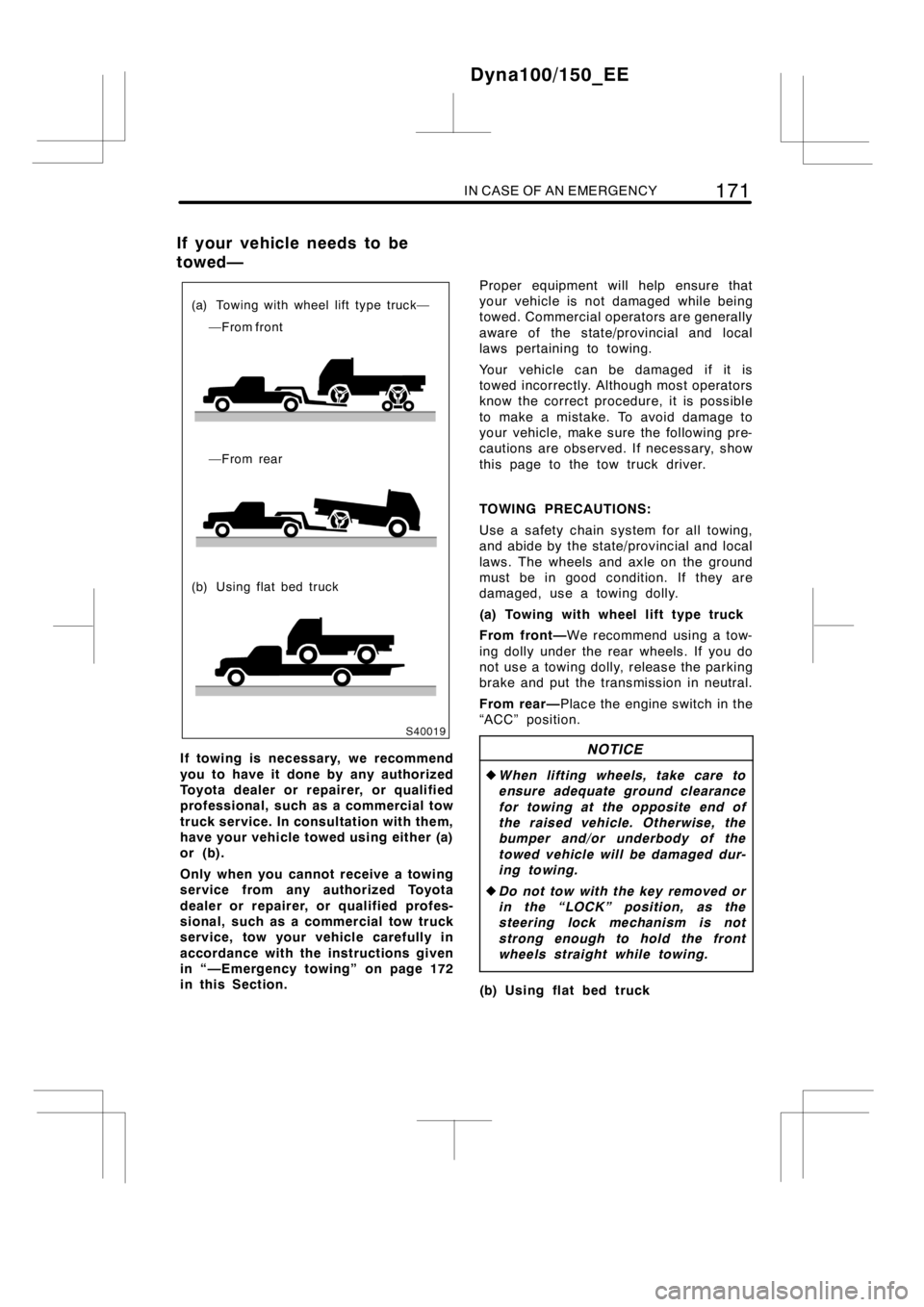2012 TOYOTA DYNA 100/150 Brake
[x] Cancel search: BrakePage 144 of 240

138STARTING AND DRIVING
Keep the door locks from freezing.
Squirt lock de−icer or glycerine into the
locks to keep them from freezing. To open
a frozen lock, try heating the key before
inserting it.
Use a washer fluid containing an anti-
freeze solution.
This product is available at any authorized
Toyota dealer or repairer and most auto
parts stores or another qualified professio-
nal. Follow the manufacturer ’s directions
for how much to mix with water.
NOTICE
Do not use engine antifreeze or any
other substitute because it may dam-
age your vehicle’s paint.
Do not use your parking brake when
there is a possibility it could freeze.
When parking, put the transmission into
first or reverse and block the front
wheels. Do not use the parking brake, or
snow or water accumulated in and around
the parking brake mechanism may freeze,
making it hard to release.
Keep ice and snow from accumulating
under the fenders.
Ice and snow built up under your fenders
can make steering difficult. During bad
winter driving, stop and check under the
fenders occasionally.
Depending on where you are driving,
we recommend you carry some emer-
gency equipment.
Some of the things you might put in the
vehicle are tire chains, window scraper,
bag of sand or salt, flares, small shovel,
jumper cables, etc.Your vehicle is designed primarily as a
passenger−and−load−carrying vehicle. Tow-
ing a trailer will have an adverse effect on
handling, performance,braking,durability
and driving economy (fuel consumption,
etc.). Your safety and satisfaction depend
on the proper use of correct equipment
and cautious driving habits. For your safe-
ty and the safety of others, you must not
overload your vehicle or trailer. Ask your
local authorized Toyota dealer or repairer,
or another duly qualified and equipped
professional, for further details before tow-
ing, as there are additional legal require-
ments in some countries.
WEIGHT LIMITS
Before towing, confirm the towing capacity,
gross vehicle mass (GVM), maximum per-
missible axle capacity (MPAC) and draw-
bar load. They are listed on page 222 in
Section 8.
When towing a trailer, observe the follow-
ing:
DThe total trailer weight (trailer weight
plus its cargo load) is within the towing
capacity.
DWhen the total trailer weight is greater
than the vehicle weight, we recommend
the use of a friction stabilizer (sway
control device).
DWhen the total trailer weight is over
2000 kg (4409 lb.), a friction stabilizer
(sway control device) is required.
Dyna100/150_EE
Trailer towing
Page 151 of 240

STARTING AND DRIVING145
DBacking with a trailer is difficult and
requires practice. Grip the bottom of
the steering wheel and move your hand
to the left to move the trailer to the
left. Move your hand to the right to
move the trailer to the right. (This pro-
cedure is generally opposite to that
when backing without a trailer.) Also,
just turn the steering wheel a little at
a time, avoiding sharp or prolonged
turning. Have someone guide you when
backing to reduce the risk of an acci-
dent.
DRemember that when making a turn,
the trailer wheels will be closer than
the vehicle wheels to the inside of the
turn. Therefore, compensate for this by
making a larger than normal turning
radius with your vehicle.
DCrosswinds and rough roads will ad-
versely affect handling of your vehicle
and trailer, causing sway. Pay attention
to the rear from time to time to pre-
pare yourself for being passed by large
trucks or buses, which may cause your
vehicle and trailer to sway. If swaying
happens, firmly grip the steering wheel
and reduce speed immediately but
gradually. Never increase speed. If it is
necessary to reduce speed, brake
slowly. Steer straight ahead. If you
make no extreme correction with the
steering or brakes, the vehicle and
trailer will stabilize.
DBe careful when passing other ve-
hicles. Passing requires considerable
distance. After passing a vehicle, do
not forget the length of your trailer and
be sure you have plenty of room be-
fore changing lanes.
DTo maintain engine braking efficiency,
when using engine braking, do not use
fifth gear.
DBecause of the added load of the trail-
er, your vehicle’s engine may overheat
on hot days (at temperatures over
30_C[85_F]) when going up a long or
steep grade with a trailer. If the engine
coolant temperature gauge indicates
overheating, pull off the road and stop
in a safe spot. Refer to “If your vehicle
overheats” on page 156 in Section 4.
DAlways place wheel blocks under both
the vehicle and trailer wheels when
parking. Apply the parking brake firmly.
Put the transmission in first or reverse.
Avoid parking on a slope with a trailer,
but if it cannot be avoided, do so only
after performing the following:
1. Apply the brakes and hold.
2. Have someone place wheel blocks un-
der both the vehicle and trailer wheels.
3. When the wheel blocks are in place,
release your brakes slowly until the
blocks absorb the load.
4. Apply the parking brake firmly.
5. Shift into first or reverse and turn off
the engine.
When restarting out after parking on a
slope:
1. With the clutch pedal depressed, start
the engine.
2. Shift into gear.
3. Release the parking brake and slowly
pull or back away from the wheel
blocks. Stop andapply your brakes.
4. Have someone retrieve the blocks.
Dyna100/150_EE
Page 152 of 240

146STARTING AND DRIVING
CAUTION
DObserve the legal maximum speeds
for trailer towing.
DSlow down and downshift before
descending steep or long downhill
grades. Do not make sudden down-
shifts while descending steep or
long downhill grades.
DAvoid holding the brake pedal down
too long or too frequently. This
could cause the brakes to overheat
and result in reduced braking effi-
ciency.
Improving fuel economy is easy—just take
it easy. It will help make your vehicle last
longer, too. Here are some specific tips
on how to save money on both fuel and
repairs:
DKeep your tires inflated at the cor-
rect pressure.Underinflation causes
tire wear and wastes fuel. See page
201 in Section 7−2 for instructions.
DDo not carry unneeded weight in
your vehicle.Excess weight puts a
heavier load on the engine, causing
greater fuel consumption.
DAvoid lengthy warm−up idling.Once
the engine is running smoothly, begin
driving—but gently. Remember, howev-
er, that on cold winter days this may
take a little longer.
DAccelerate slowly and smoothly.
Avoid jackrabbit starts. Get into high
gear as quickly as possible.
DAvoid long engine idling.If you have
a long wait and you are not in traffic,
it is better to turn off the engine and
start again later.
DAvoid engine lugging or over−rev-
ving.Use a gear position suitable for
the road on which you are travelling.
DAvoid continuous speeding up and
slowing down.Stop−and−go driving
wastes fuel.
DAvoid unnecessary stopping and
braking.Maintain a steady pace. Try
to time the traffic signals so you only
need to stop as little as possible or
take advantage of through streets to
avoid traffic lights. Keep a proper dis-
tance from other vehicles to avoid sud-
den braking. This will also reduce wear
on your brakes.
DAvoid heavy traffic or traffic jams
whenever possible.
DDo not rest your foot on the clutch
or brake pedal.This causes premature
wear, overheating and poor fuel econo-
my.
Dyna100/150_EE
How to save fuel and make
your vehicle last longer
Page 153 of 240

STARTING AND DRIVING147
DMaintain a moderate speed on high-
ways.The faster you drive, the greater
the fuel consumption. By reducing your
speed, you will cut down on fuel con-
sumption.
DKeep the front wheels in proper
alignment.Avoid hitting the curb and
slow down on rough roads. Improper
alignment not only causes faster tire
wear but also puts an extra load on
the engine, which, in turn, wastes fuel.
DKeep the bottom of your vehicle free
from mud, etc.This not only lessens
weight but also helps prevent corro-
sion.
DKeep your vehicle tuned−up and in
top shape.A dirty air cleaner, carbure-
tor out of adjustment, improper valve
clearance, dirty plugs, dirty oil and
grease, brakes not adjusted, etc. all
lower engine performance and contrib-
ute to poor fuel economy. For longer
life of all parts and lower operating
costs, keep all maintenance work on
schedule, and if you often drive under
severe conditions, see that your vehicle
receives more frequent maintenance.
CAUTION
Never turn off the engine to coast
down hills. Your power steering and
brake booster will not function with-
out the engine running. Also, the
emission control system operates
properly only when the engine is run-
ning.
Dyna100/150_EE
Page 161 of 240

IN CASE OF AN EMERGENCY155
If your engine stalls while driving...
1. Reduce your speed gradually, keeping
a straight line. Move cautiously off the
road to a safe place.
2. Turn on your emergency flashers.
3. Try starting the engine again.
If the engine will not start, see “If your
vehicle will not start” on page 150.
CAUTION
If the engine is not running, the pow-
er assist for the brakes and steering
will not work so steering and braking
will be much harder than usual.
If engine speed does not increase when
the accelerator pedal is depressed, there
may be a problem somewhere in the elec-
tronic engine controlsystem. Stop the ve-
hicle and contact any authorized Toyota
dealer or repairer, or another duly quali-
fied and equipped professional, or take
your vehicle carefully, since the vehicle
performance will be lower than normal, to
any authorized Toyota dealer or repairer,
or another duly qualified and equipped
professional, as soon as possible.
Even if the abnormality in the electronic
engine controlsystem is corrected during
low speed driving, thesystem may not
recover until the engine is stopped and
the engine switch is turned to the “ACC”
or “LOCK” position.
Dyna100/150_EE
If your engine stalls while
drivingIf you cannot increase engine
speed
Page 162 of 240

156IN CASE OF AN EMERGENCY
If your engine coolant temperature
gauge indicates overheating, if you ex-
perience a loss of power, or if you hear
a loud knocking or pinging noise, the
engine has probably overheated. You
should follow this procedure...
1. Pull safely off the road, stop the ve-
hicle, and turn on your emergency
flashers. Put the transmission in neu-
tral and apply the parking brake. Turn
off the air conditioning if it is being
used.
2. If coolant or steam is boiling out of the
radiator or reservoir, stop the engine.
Wait until the steam subsides before
opening the engine access hole cover
or tilting the cab. If there is no coolant
or steam boiling over, leave the engine
running and make sure the electric
cooling fan is operating. If it is not,
turn the engine switch off.
CAUTION
To help avoid serious injury, keep the
engine access hole cover closed or
the cab lowered until there is no
steam. Escaping steam or coolant is
a sign of very high pressure.
3. Visually check to see if the engine
drive belt (fan belt) is broken or loose.
Look for obvious coolant leaks from the
radiator, hoses, and under the vehicle.
However, note that water draining from
the air conditioning is normal if it has
been used.
CAUTION
When the engine is running, keep
hands and clothing away from the
moving fan and engine drive belts.
4. If the engine drive belt is broken or the
coolant is leaking, stop the engine im-
mediately. Call any authorized Toyota
dealer or repairer, or another duly qual-
ified and equipped professional, for as-
sistance.
5. If the engine drive belt is O.K. and
there are no obvious leaks, you may
help the engine cool down more quickly
by running it at about 1500 rpm for a
few minutes with the accelerator pedal
lightly depressed.
6. Check the coolant reservoir. If it is dry,
add coolant to the reservoir while the
engine is running. Fill it about half full.
For the coolant type, see “Coolant type
selection” on page 199 in Section 7−2.
CAUTION
Do not attempt to remove the radiator
cap when the engine and radiator are
hot. Serious injury could result from
scalding hot fluid and steam blown
out under pressure.
7. After the engine coolant temperature
has cooled to normal, again check the
coolant level in the reservoir. If neces-
sary, bring it up to half full again.
Serious coolant loss indicates a leak in
the system. You should have it
checked as soon as possible at any
authorized Toyota dealer or repairer, or
another duly qualified and equipped
professional.
Dyna100/150_EE
If your vehicle overheats
Page 163 of 240

IN CASE OF AN EMERGENCY157
1. Reduce your speed gradually, keeping
a straight line. Move cautiously off the
road to a safe place well away from
the traffic. Avoid stopping on the center
divider of a highway. Park on a level
spot with firm ground.
2. Stop the engine and turn on your
emergency flashers.
3. Firmly set the parking brake and put
the transmission in reverse.
4. Have everyone get out of the vehicle
onthesideawayfromtraffic.
5. Read the following instructions thor-
oughly.
CAUTION
When jacking, be sure to observe the
following to reduce the possibility of
death or serious injury:
DFollow jacking instructions.
DDo not put any part of your body
under the vehicle supported by the
jack. Otherwise, death or serious
injury may occur.
DDo not start or run the engine while
your vehicle is supported by the
jack.
DStop the vehicle on a level firm
ground, firmly set the parking brake
and put the transmission in reverse.
Block the wheel diagonally opposite
to the one being changed if neces-
sary.
DMake sure to set the jack properly
in the jack point. Raising the ve-
hicle with jack improperly posi-
tioned will damage the vehicle or
may allow the vehicle to fall off the
jack and cause death or serious in-
jury.
DNever get under the vehicle when
the vehicle is supported by the jack
alone.
DUse the jack only for lifting your
vehicle during wheel changing.
DDo not raise the vehicle with some-
one in the vehicle.
DWhen raising the vehicle, do not
place any objects on top of or un-
derneath the jack.
DRaise the vehicle only high enough
to remove and change the tire.
NOTICE
Do not continue driving with a de-
flated tire. Driving even a short dis-
tance can damage a tire and wheel
beyond repair.
Dyna100/150_EE
If you have a flat tire—
Page 177 of 240

IN CASE OF AN EMERGENCY171
(a) Towing with wheel lift type truck—
—From front
—From rear
(b) Using flat bed truck
If towing is necessary, we recommend
you to have it done by any authorized
Toyota dealer or repairer, or qualified
professional, such as a commercial tow
truck service. In consultation with them,
have your vehicle towed using either (a)
or (b).
Only when you cannot receive a towing
service from any authorized Toyota
dealer or repairer, or qualified profes-
sional, such as a commercial tow truck
service, tow your vehicle carefully in
accordance with the instructions given
in “—Emergency towing” on page 172
in this Section.Proper equipment will help ensure that
your vehicle is not damaged while being
towed. Commercial operators are generally
aware of the state/provincial and local
laws pertaining to towing.
Your vehicle can be damaged if it is
towed incorrectly. Although most operators
know the correct procedure, it is possible
to make a mistake. To avoid damage to
your vehicle, make sure the following pre-
cautions are observed. If necessary, show
this page to the tow truck driver.
TOWING PRECAUTIONS:
Use a safety chain system for all towing,
and abide by the state/provincial and local
laws. The wheels and axle on the ground
must be in good condition. If they are
damaged, use a towing dolly.
(a) Towing with wheel lift type truck
From front—We recommend using a tow-
ing dolly under the rear wheels. If you do
not use a towing dolly, release the parking
brake and put the transmission in neutral.
From rear—Place the engine switch in the
“ACC” position.NOTICE
zWhen lifting wheels, take care to
ensure adequate ground clearance
for towing at the opposite end of
the raised vehicle. Otherwise, the
bumper and/or underbody of the
towed vehicle will be damaged dur-
ing towing.
zDo not tow with the key removed or
in the “LOCK” position, as the
steering lock mechanism is not
strong enough to hold the front
wheels straight while towing.
(b) Using flat bed truck
Dyna100/150_EE
If your vehicle needs to be
towed—